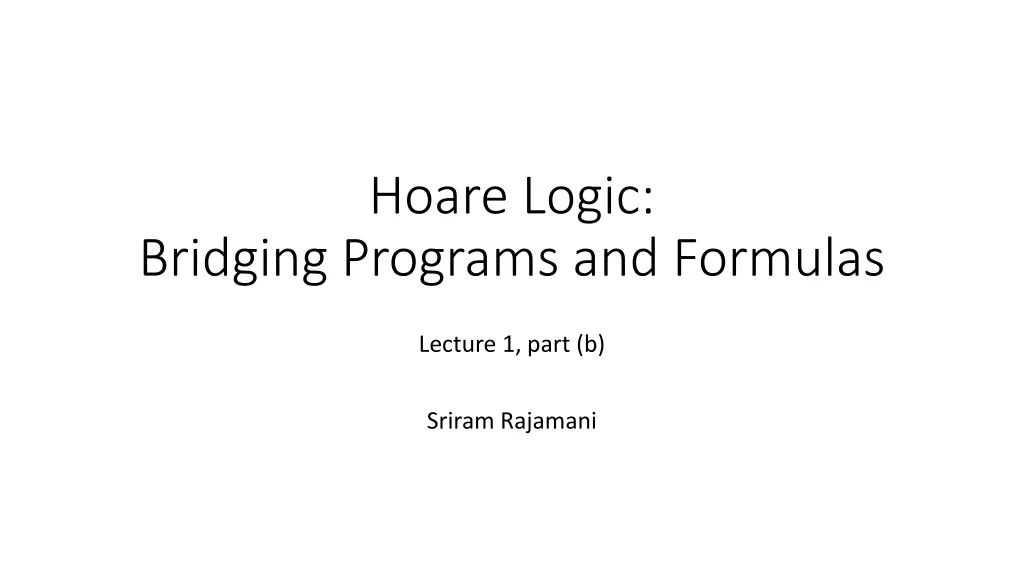
Understanding Hoare Logic and Verification Procedures
Learn about Hoare Logic, a logical system connecting programs and formulas for correctness verification and synthesis. Explore examples, proof rules, and the essence of Hoare triples for ensuring program correctness.
Uploaded on | 2 Views
Download Presentation

Please find below an Image/Link to download the presentation.
The content on the website is provided AS IS for your information and personal use only. It may not be sold, licensed, or shared on other websites without obtaining consent from the author. If you encounter any issues during the download, it is possible that the publisher has removed the file from their server.
You are allowed to download the files provided on this website for personal or commercial use, subject to the condition that they are used lawfully. All files are the property of their respective owners.
The content on the website is provided AS IS for your information and personal use only. It may not be sold, licensed, or shared on other websites without obtaining consent from the author.
E N D
Presentation Transcript
Hoare Logic: Bridging Programs and Formulas Lecture 1, part (b) Sriram Rajamani
A Hoare triple is a formula of the form {P} Q {R} where P and R are predicates Q is a program statement Partial correctness: If we start the program at a state satisfying P, and run the statement Q, and the execution of Q terminates, the resulting state satisfies the predicate R Total correctness: If we start the program at a state satisfying P, and run the statement Q, the execution of Q terminates and the resulting state satisfies the predicate R
Verification and synthesis using Hoare Logic Given a program ? with some correctness condition ? (specified as pre-post conditions or assertions): We can compile ? and ? into a formula ? such that ? satisfies ?, iff ? is valid To do verification, the formula ? is usually quantifier free. In order to do synthesis, we consider ?with some holes , and the compilation results in a formula ? with quantifiers.
Hoare Logic A logical system that connects imperative programs to formulas Basis of all conversions between programs and formulas, as well as for mixing programs and formulas
Example (1) {true} max = -MAXINT; i = 0; while (i < N) { if( a[i] > max) max = a[i]; i = i+1; } { j 0 ?< ?. ?[?] max}
Example (2) {(? > 0) (? > 0)} x1 = x; y1 = y; while (x1 y1) do if x1>y1 then x1=x1-y1 else y1 = y1-x1 { ?1 = ?1 (?1 = gcd(?,?)}
Example (2) {(? > 0) (? > 0)} x1 = x; y1 = y; while (x1 y1) do if x1>y1 then x1=x1-y1 else y1 = y1-x1 { ?1 = ?1 (?1 = gcd(?,?)} Suppose that x1, y1 are both positive integers. Then gcd is a function which satisfies the following formulas: ?1 > ?1 gcd(?1,?1) = gcd(?1 ?1,?1) ?1 > ?1 gcd(?1,?1) = gcd(?1,?1 ?1) ( ?1 = ?1) gcd(?1,?1) = ?1 = ?1
Proof rules for Hoare logic A recipe of rules We will first go through the rules and do manual proofs Then we will look at automation
Assignment rule {?[? ?]} ? = ? {?} Examples {y+5=10} y=y+5 {y=10} {y+y<z} x =y {x+y<z} {2*(y+5)>20} y =2*(y+5) {y>20}
Sequential Composition Show: {x+1=y+2} x:=x+1; y:=y+2 {x=y}
Conditional Composition gcd ?,? = gcd ?1,?1 ?1 > 0 ?1 > 0 (?1 ?1) if (x1>y1) then x1=x1-y1 else y1 = y1-x1 gcd ?,? = gcd ?1,?1 ?1 > 0 ?1 > 0
Rule for while loop {gcd ?,? = gcd ?1,?1 ?1 > 0 ?1 > 0 } while (x1 y1) do if x1>y1 then x1=x1-y1 else y1 = y1-x1 {gcd ?,? = gcd ?1,?1 ?1 > 0 ?1 > 0 (?1 = ?1) }
Connection to mathematical induction In many cases the loop invariant needs to be stronger than the postcondition of the loop. This is similar to proof by induction, when in some cases the induction hypothesis needs to be stronger than the desired conclusion
Can you now prove? {(? > 0) (? > 0)} x1 = x; y1 = y; while (x1 y1) do if x1>y1 then x1=x1-y1 else y1 = y1-x1 { ?1 = ?1 (?1 = gcd(?,?)}
Can you prove? {true} max = -MAXINT; i = 0; while (i < N) { if( a[i] > max) max = a[i]; i = i+1; } { j 0 ?< ?. ?[?] max}
Homework: Prove the following {? 0 ? 0} a=0; b=x; while b y { b=b-y; a=a+1 } { ? = ? ? + ? ? 0 ? < ? }
Partial vs total correctness We covered only partial correctness. Total correctness can also be proved with Hoare logic, but with an extra rule that reasons about a ranking function to prove termination.
Soundness and completeness Every assertion proved by Hoare logic is correct. This is called soundness . Soundness follow from each of the rules (or axioms) of Hoare logic being correct. However, not every correct assertion can be proved using Hoare logic. Hence, Hoare logic is incomplete. Also note the connection to the halting problem. If we can prove {true} S {false}, then we know that S may not halt.
Weakest precondition, Strongest postcondition For an assertion ? and program ?, let ????(?,?) be the strongest assertion such that {?}?{????(?,?)} That is, for any q if {?}?{?} then ????(?,?) ? For an assertion ? and code ?, let ???(?,?) be the weakest assertion such that ??? ?,? ? ? That is, if {?}?{?} then ? ???(?,?)
Homework Find out concrete algorithms to calculate strongest post conditions, weakest preconditions, and in general verification condition generation Check out Boogie. https://www.microsoft.com/en- us/research/project/boogie-an-intermediate-verification-language/ Read the following paper on Sketch: Armando Solar-Lezama. 2013. Program sketching. Int. J. Softw. Tools Technol. Transf. 15, 5-6 (October 2013), 475-495. DOI: https://doi.org/10.1007/s10009-012- 0249-7 Available at: https://core.ac.uk/download/pdf/78071595.pdf
